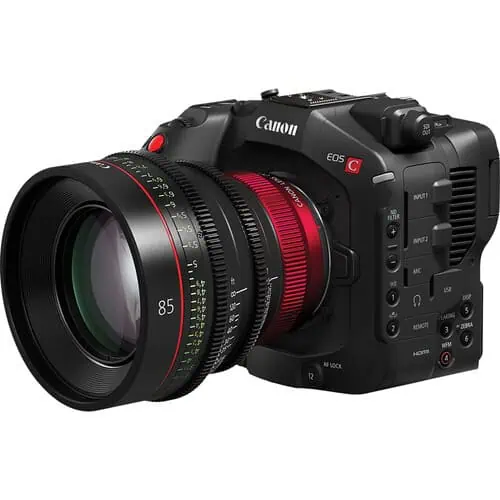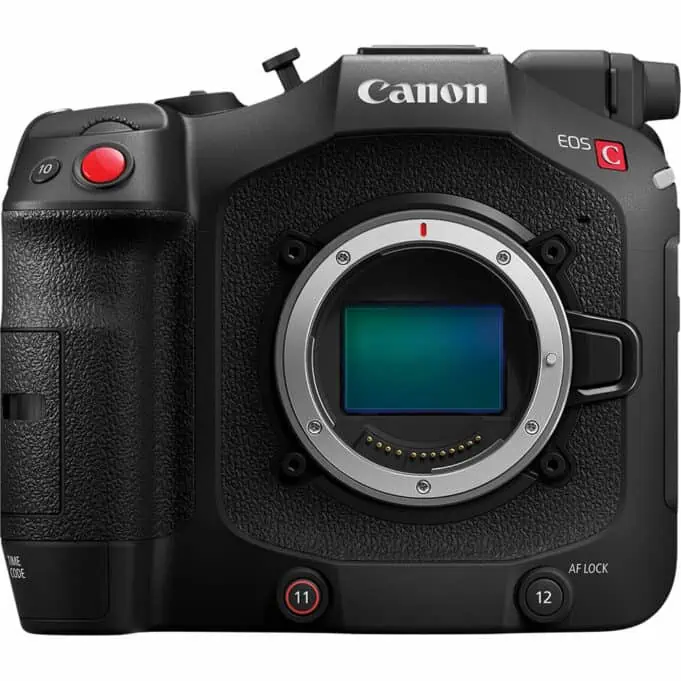Well, well, well. Canon seems to be on quite the roll lately. If you were looking to buy an affordable new cinema camera or upgrade an existing one it will be hard not to at least consider the ever expanding Canon Cinema range.
The latest example: the new Canon EOS C80.
Featuring a 6K full-frame sensor and (relatively) new RF lens mound, the C80 — a successor to the popular EOS C70 — looks to be a perfect run-and-gun, wedding, indie, and corporate camera. With it’s small size it could be also be a good fit for travel shooters.
Coming on the heals of the more fully-featured C400 cinema camera, the C80 does forfeit a few features here and there all in the interest of smaller size and smaller price. For instance, whereas the C400 features a CFexpress slot, the C80 sticks with old school SD cards — slower transfer speeds, but much lower cost to buy.
Canon EOS C80 6K Full-Frame Cinema Camera
Key Features
- 6K FF Back-Illuminated CMOS Sensor (same as the Canon EOS C400)
- 6K30, DCI 4K/2K, UHD 4K120 S35 Recording
- Full Frame and Super35 Modes
- 12G-SDI and HDMI Simultaneous Output
- Triple-Base ISO: 800, 3200, 12,800
- Cinema Raw Light LT, HEVC, AVC Codecs
- 16+ Stops of Total Dynamic Range
- Dual-Pixel CMOS AF II, Built-In NDs
- 1 x BNC Timecode, 2 x Mini-XLR Audio In
- MSRP: $5,499 USD
- Availability: Friday, November 29, 2024
Source: B&H Photo
Stark Insider Take: Canon EOS C80
There’s a lot to like here. I think Canon found the sweet spot and delivered a cinema camera that has a great sensor, ergonomic DSLR-like design (tried and true), and reasonable price. If you were currently cross-shopping things like the RED Komodo and Komodo-X, Blackmagic PYXIS and Sony FX6 you’d want to at least take a moment to consider the C80 and check out its specs to see if it might suit your projects.
Keen spec fiends might notice one thing absent from the C80 vs. the C400: Super 16 mode.
For me that’s a bit of a bummer. Whereas the C400 can shoot in Full-Frame, Super 35 and Super 16 mode, the C80 can only shoot in either Full-Frame of Super 35. While still fine more most, I do wish the Super 16 mode was there so I could use some of my favorite vintage lens. There is a possibility, of course, that Super 35 mode will work and the unused black vignettes can be cropped out in post. Maybe I’m alone in this particular spec, but having the flexibility to shoot in those three modes is a handy capability to have on hand for any given film project.
That aside, Canon provides a lot of features. Too many to ignore. For instance, there’s a new PL-RF adapter option which will be useful for those using the C80 on professional film sets as a b- or c-cam.
Motorized built-in ND filters will be appreciated by those who work in the field and prefer not to deal with the hassle of screw-on lens filters. Very handy — and something not found on the upcoming Blackmagic Design P6K PYXIS (though, to be fair, that camera is much, much less expensive).
Pretty much everything else any modern shooter would want these days is here as well including:
- Mini-XLR inputs
- Canon Log 2 and 3
- 12G SDI BNC output
Good stuff.
And, of course, let’s not forget Canon’s ever-amazing AF tech. Dual-Pixel Auto-Focus just keeps getting better. If you’ve ever shot with it on something like the C100/C200 you know how smooth and fast it responds. In my experience, there’s nothing quite like it — though Sony is getting close!
Overall, the Canon EOS C80 looks like it will be a strong seller. At $5,499 USD it’s priced $2,500 less than the RED/Nikon Komodo-X (which recently underwent a substantial price cut), and $500 less than the Sony FX6, probably its most closely matched competitor on the market today.
The Canon EOS 80D is available for preorder today ($5,499 body only) and is scheduled to start shipping November 29.




